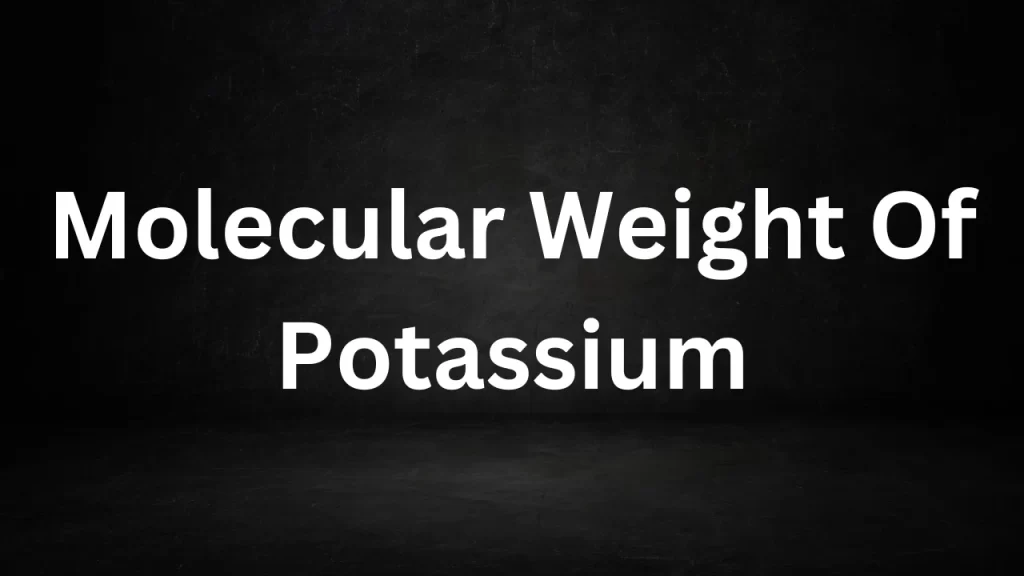Tag: molecular weight of potassium
Molecular Weight Of Potassium
Molecular Weight Of Potassium: Potassium is a chemical element found in the alkali metal group of the periodic table, denoted by the symbol K. In the field of chemistry, understanding the molecular weight of potassium is essential as it plays a significant role in various chemical reactions and scientific calculations.
This article will delve into the concept of molecular weight, explain how it relates to potassium, and discuss the significance of this knowledge in both theoretical and practical contexts.

Molecular Weight Of Potassium
Molecular Weight: An Overview
The mole weight, also known as molar mass, is a fundamental concept in chemistry. It represents the mass of one mole of a particular substance and is typically expressed in grams per mole (g/mol). A mole is a unit used to quantify the amount of a substance and contains approximately 6.022 x 10^23 entities, known as Avogadro’s number. Molecular weight is numerically equivalent to the atomic or mole weight of the substance.
The Molecular Weight of Potassium (K)
Potassium exists naturally in the form of various isotopes, but the most abundant and stable isotope is potassium-39 (^39K). To calculate the mole weight of potassium, we consider this dominant isotope.
The atomic mass of potassium-39 is approximately 38.963 g/mol. Therefore, the mole weight of potassium (K) is:
mole Weight of Potassium (K) = Atomic Mass of ^39K ≈ 38.963 g/mol
Significance of Molecular Weight of Potassium
Understanding the mole weight of potassium holds great significance in the field of chemistry and beyond:
1. Chemical Reactions:
The mole weight of potassium plays a pivotal role in chemical reactions that incorporate potassium compounds. It helps determine the stoichiometry, allowing chemists to balance equations and calculate reactant and product quantities accurately.
2. Analytical Chemistry:
In analytical chemistry, the knowledge of mole weight aids in the determination of concentrations, particularly in techniques like titration and gravimetric analysis.
3. Industrial Applications:
Potassium and its compounds have various industrial applications, such as in fertilizers, detergents, and glass production. Understanding mole weight is vital for precise formulation and quality control.
4. Medicine and Healthcare:
In the field of medicine, potassium is essential for numerous physiological processes in the human body. Knowing its molecular weight is essential for medication formulations and dosages.
5. Environmental Sciences:
mole weight plays a role in environmental studies, such as analyzing soil and water composition, where potassium content can impact ecosystem health.
6. Agriculture:
Potassium is a vital nutrient for plant growth. Understanding its mole weight is critical in formulating fertilizers and determining optimal application rates for crop production.
Conclusion
The mole weight of potassium (K) is a fundamental concept in chemistry with broad applications across various scientific disciplines and industries. It enables precise calculations, facilitates the formulation of chemicals and medications, and plays a vital role in understanding natural processes and environmental factors. By comprehending the mole weight of potassium, scientists, chemists, and professionals can make informed decisions and contributions to diverse fields, from agriculture to healthcare, ultimately benefiting society and advancing our understanding of the natural world.
Read More
- Molecular Weight Of O2
- Calcium Carbonate Molar Mass
- Molar Mass Of Ammonia
- Molecular Mass Of Acetic Acid
- Molecular Weight Of Calcium Carbonate
Frequently Asked Questions (FAQs) Molecular Weight Of Potassium
1. What is the molecular weight of potassium (K)?
The mole weight of potassium, denoted as K, is approximately 38.963 grams per mole (g/mol). This value is based on the most abundant and stable isotope of potassium, which is potassium-39 (^39K).
2. Why is the molecular weight of potassium important in chemistry?
The mole weight of potassium is crucial in chemistry because it helps in stoichiometry, which involves balancing chemical equations and determining the quantities of potassium compounds involved in chemical reactions.
3. How is the molecular weight of potassium calculated?
The mole weight of potassium is calculated by considering the atomic mass of its most abundant isotope, potassium-39 (^39K), which is approximately 38.963 g/mol.
4. What is the significance of knowing the molecular weight of potassium in analytical chemistry?
In analytical chemistry, the mole weight of potassium is important for accurately etermining concentrations of potassium compounds in various samples, such as in titration and gravimetric analysis.
4. Are there practical applications of the molecular weight of potassium in industries?
Yes, potassium and its compounds are used in various industries, including agriculture (fertilizers), detergents, glass production, and metallurgy. Knowing the molecular weight is vital for formulation and quality control in these applications.
Molar Mass Of Potassium (K)
Molar Mass Of K: In the world of chemistry, one of the fundamental concepts is the molar mass of an element. It is essential in diverse chemical computations, encompassing substance quantification in samples and forecasting reaction results.
This article delves into potassium’s (K) molar mass, examining its importance within the realm of chemistry and its various applications.

Molar Mass Of K
Potassium (K) – A Brief Overview:
Potassium, symbolized as K with atomic number 19, is classified within the alkali metal group on the periodic table. This element holds significant importance as an essential nutrient vital for the well-being of all living organisms, including humans. Potassium ions (K+) play a pivotal role in various physiological processes, such as nerve signal transmission, muscle contractions, and cellular functionality, making them indispensable in the realm of biology.
Determining the Molar Mass of Potassium:
The molar mass of an element is the mass of one mole of that element, in grams per mole (g/mol). To calculate potassium’s molar mass, we use its atomic mass, found on the periodic table, approximately 39.10 atomic mass units (amu).
However, in chemical calculations, we usually consider the molar mass of potassium as 39.10 g/mol. This is because the atomic mass unit (amu) is a very small unit of measurement, and it is more convenient to work with grams per mole in laboratory settings and chemical equations.
The molar mass of potassium (K) is, therefore, 39.10 g/mol.
Significance of Molar Mass in Chemistry:
- Stoichiometry: Molar mass is crucial in stoichiometry, the branch of chemistry that deals with the quantitative relationships between reactants and products in chemical reactions. It helps in determining the amount of reactants needed or products formed during a chemical reaction.
- Empirical and Molecular Formulas: Molar mass aids in deducing the empirical and molecular formulas of compounds by comparing it with elemental composition. This reveals atom ratios and compound formulas.
- Concentration Calculations: In solutions and mixtures, molar mass is essential for calculating concentrations. For example, it is employed in calculating the molarity (M) of a solution, defined as the moles of solute per liter of solution.
- Gas Laws: Molar mass is crucial in gas law calculations, such as the ideal gas law (PV = nRT). It helps convert between mass, moles, and volume when dealing with gases.
- Chemical Reactions: Molar mass is instrumental in achieving balance in chemical equations, ensuring compliance with the law of conservation of mass.
Applications of Potassium (K) in Chemistry:
Aside from its importance in understanding molar mass, potassium itself has various applications in chemistry. Some notable examples include:
- Potassium Hydroxide (KOH): Used in the manufacture of soap and as a strong base in chemical processes.
- Potassium Nitrate (KNO3): Used in fireworks, fertilizers, and as a food preservative.
- Potassium Permanganate (KMnO4): A powerful oxidizing agent used in various chemical reactions and water treatment.
Conclusion:
Potassium’s (K) molar mass is a foundational concept in chemistry, with a pivotal role in multiple aspects of the field. Understanding the molar mass of elements is essential for accurate chemical calculations, stoichiometry, and the study of chemical reactions. Potassium’s molar mass, 39.10 g/mol, is significant not just in chemistry but also vital as a nutrient for all living organisms.
Read More
- Molar Mass Of Magnesium
- Law Of Conservation Of Energy
- Difference Between Equinox And Solstice
- Molecular Weight Of K2Cr2O7
- Molecular Weight Of Phosphorus
Frequently Asked Questions (FAQs) On Molar Mass Of K
Q1: What is molar mass?
A1: Molar mass, measured in grams per mole (g/mol), represents the mass of a single mole of a substance. This foundational concept in chemistry plays a pivotal role in various calculations, encompassing stoichiometry and the determination of substance quantities within samples.
Q2: What is the molar mass of potassium (K)?
A2: The molar mass of potassium (K) is approximately 39.10 grams per mole (g/mol). This value is commonly used in chemical calculations and is found on the periodic table.
Q3: Why is molar mass important in chemistry?
A3: Molar mass is important in chemistry because it allows chemists to relate the mass of a substance to the number of moles of that substance. It is essential for stoichiometry, determining chemical formulas, calculating concentrations, and balancing chemical equations.
Q4: How is the molar mass of an element determined?
A4: The molar mass of an element is calculated by adding up the atomic masses of all the atoms in one mole of that element. This information is typically found on the periodic table and is expressed in atomic mass units (amu). To apply it in chemical computations, the atomic mass is converted to grams per mole (g/mol).
Q5: Is the molar mass of potassium used only in chemistry?
A5: Although potassium’s molar mass is predominantly utilized in chemistry, potassium has diverse applications beyond the field. For instance, potassium compounds are integral to fireworks, fertilizers, and soap production.